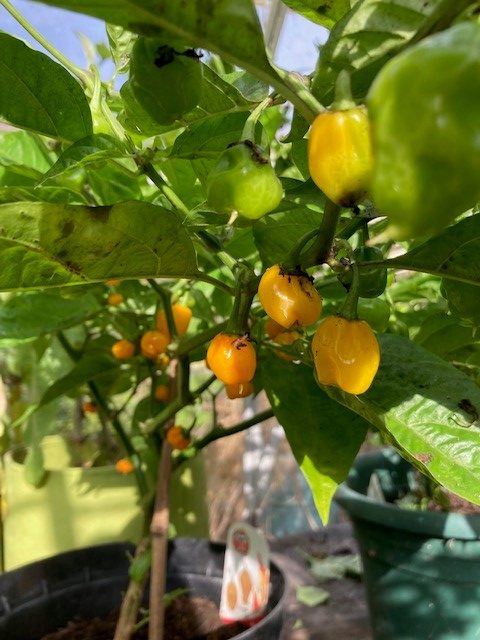
Last month I talked about the ripening of my tomatoes and aubergines in the greenhouse, and now it is the turn of the chillies. The tomatoes and aubergines are all but over now: we harvested the last few aubergines for one big glorious end of season bowl of baba ganoush, which will be eaten with a salad of the last tomatoes on the side. The chillies though are a slightly different matter. Many of them have now ripened but equally a great number are still to come. With light levels dropping daily and temperatures with them it is time to bring them indoors to finish off the ripening.
There are a few different ways to go about this. If you have the space then just moving the chilli plants indoors, lock, stock and barrel, is possibly the best thing you can do. In a sunny and heated conservatory or in the house and next to a south-facing window the chillies will most definitely continue to ripen. The plants may even continue to grow and produce more fruits, but it is sensible to nip off any new ones that try to form now, and concentrate all of the plant’s energy into ripening those that have already formed. Plants brought indoors will not need a great amount of water, in fact, restricting water can help them to ripen faster, so just give them a little trickle now and then.
But most of us don’t have that space, and will need another technique. So another possibility is to cut the fruit-covered branches off and hang them somewhere light and airy while the fruits gradually ripen. This could be indoors if you have a suitable spot, or it could be from the roof ridge of the greenhouse. Leave them there for as long as it takes for them to dry out and then bring them indoors to use in cooking or as a decoration (or both!). If you do this you might also want to try perennialising the plant: although we generally grow chillies as annuals they are in fact tender perennials – it just suits our climate to grow them as annuals, and they can actually be overwintered really successfully and pretty easily. Leave the trimmed plant in its pot or shake the soil off of the root and plant it up in a smaller pot to save space. Overwintered chillies can’t be left in a cold greenhouse all winter though, and will need to be somewhere that is kept at a minimum of 10C all winter. Give them a trickle of water every now and then over winter and then pot it up into a larger pot of fresh compost next spring, increasing water as the weather starts to warm.
A final technique – and the one I am going for with my chillies, is to make a chilli string, or ristra, which as well as being a good practical way to dry and store your cjhillies also makes a beautiful decoration and an opportunity to show off your crop. First cut off all of the chillies and then take a length of thread 30cm or so in length. Double knot one end, thread your needle and then begin threading the chillies onto the thread, putting the needle through from one side of the green part to the other. Continue until all of the chillies are attached to the string and then hang somewhere light and airy where it will not get damp. Pluck off the chillies all winter, as you need them.
Chillies are strung together and then hung in a light and airy place to dry.










